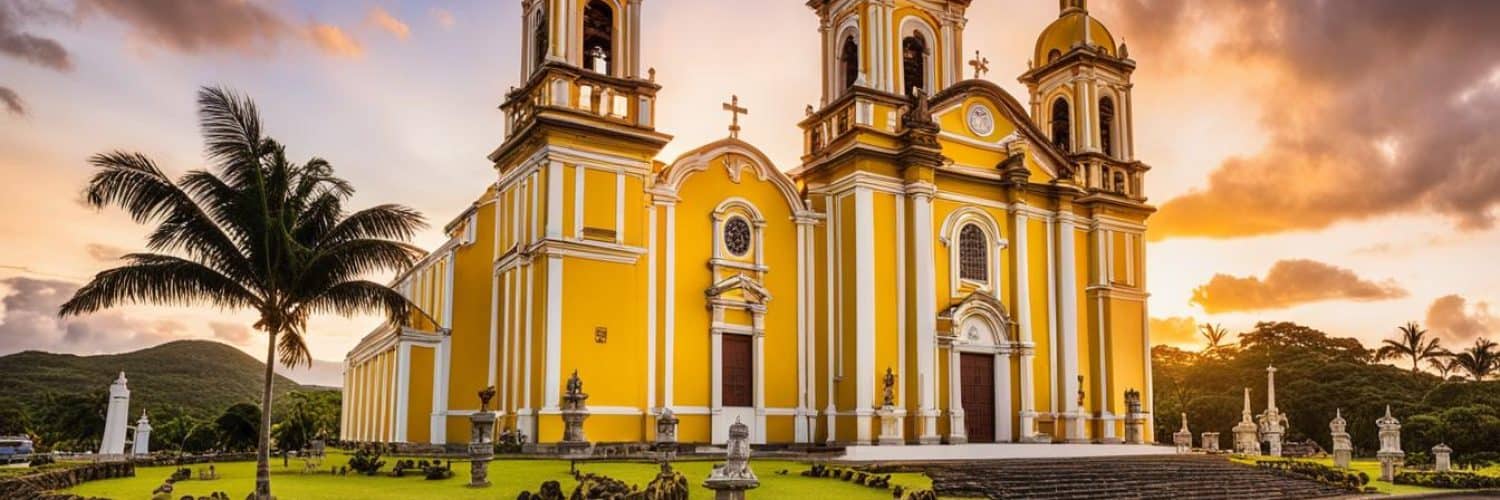Welcome to Tumauini Church in Isabela, Philippines, a historical church that stands as a true testament to Spanish colonial architecture and Baroque style. This architectural masterpiece is not only a top tourist spot but also a religious landmark and an important part of our cultural heritage. Let’s explore the beauty and significance of this preserved heritage site.
Key Takeaways:
- Tumauini Church in Isabela, Philippines, is a historical church with stunning Spanish colonial Baroque architecture
- It is a candidate for inclusion in the UNESCO World Heritage Sites, highlighting its cultural importance
- The church attracts tourists from all over the world and is considered a top tourist spot in Isabela
- Tumauini Church is a religious landmark and holds great significance in Filipino culture
- Preservation efforts are underway to maintain the church’s historical and architectural integrity
Historical Significance of Tumauini Church
Tumauini Church holds great historical significance, dating back to the Spanish colonial era. Founded in 1707 as an independent parish under the advocacy of Saint Matthias, it has played a vital role in the religious and cultural landscape of Isabela, Philippines. The current church building, designed and constructed by Dominican architect-friar Domingo Forto, was completed in 1805.
Throughout its existence, Tumauini Church has weathered the test of time, witnessing the passage of centuries and the transformation of landscapes. Its architectural splendor and spiritual significance reflect the enduring legacy of Spanish colonial influence in the Philippines.
Recognizing its importance as a cultural heritage site, Tumauini Church has been designated as a National Cultural Treasure by the National Museum of the Philippines. This prestigious recognition highlights its historical, architectural, and artistic value, underscoring its significance in preserving the nation’s heritage.
“Tumauini Church stands as a testament to the harmonious blend of faith, culture, and architectural grandeur that defined the Spanish colonial era in the Philippines.”
The church’s status as a National Cultural Treasure establishes its role as a custodian of history, offering visitors a glimpse into the past and fostering a sense of reverence for the country’s rich cultural heritage. As a well-preserved relic of the Spanish colonial era, Tumauini Church serves as a living testament to the enduring contributions of the Catholic faith and the influence of European architectural styles in the Philippines.
Architectural Splendor of Tumauini Church
Tumauini Church is a true architectural masterpiece that evokes a sense of awe and wonder. Its Baroque-style design and use of red bricks make it stand out as a gem of architectural splendor. The entire church, including its facade and interior walls, is constructed with beautiful red bricks, giving it a distinctive and captivating presence.
The facade of Tumauini Church is a true testament to the rococo-baroque style, adorned with intricate ornamentation that showcases the skilled craftsmanship of its builders. Delicate flowers, leaves, ovules, and sunbursts create a symphony of artistic expression that adds to the church’s visual appeal.
One of the unique features of Tumauini Church is its curved pediment, a rarity among Spanish-era churches. This architectural element adds a touch of elegance and uniqueness to the church’s overall design, making it a noteworthy landmark for architectural enthusiasts.
The use of red bricks in the construction of Tumauini Church was born out of necessity. The lack of good quality stones in the area led the builders to employ red bricks, resulting in a vibrant and distinct facade that has stood the test of time.
“The architectural splendor of Tumauini Church is truly remarkable. The intricate details, the use of red bricks, and the rococo-baroque facade all contribute to its unique beauty and significance in Philippine architectural history.”
The architectural splendor of Tumauini Church is a testament to the skill and artistry of its builders. It continues to captivate visitors and serves as a reminder of the rich cultural heritage of the Philippines.
Unique Features of Tumauini Church
Tumauini Church is renowned for its unique architectural features that make it a true standout among Spanish-era churches.
One of its most distinctive characteristics is the circular pediment that adorns the facade of the church. Unlike the triangular pediments typically found in other churches of the same era, Tumauini Church’s circular pediment adds a touch of elegance and uniqueness to its appearance. The intricate details and ornate decorations on the pediment further enhance its visual appeal.
Another remarkable feature of Tumauini Church is its cylindrical bell tower. Built in 1805, it is the only known Spanish colonial era cylindrical tower in the Philippines. Resembling a wedding cake in its design, the bell tower adds to the architectural charm of the church. Despite bearing bullet holes from past conflicts, the bell housed within the tower has never been recast, serving as a testament to its historical significance.
| Unique Features | Description |
|---|---|
| Circular Pediment | An elegant feature adorning the facade, setting it apart from other churches |
| Cylindrical Bell Tower | The only known Spanish colonial era cylindrical tower in the Philippines |
These unique features contribute to the overall splendor of Tumauini Church, making it an architectural masterpiece and a must-visit destination for history and art enthusiasts.
Preservation Efforts and Cultural Recognition
Tumauini Church is not only cherished for its historical and architectural significance, but also for its continuous preservation efforts. Recognizing the importance of safeguarding this cultural heritage site, the National Museum of the Philippines declared Tumauini Church as a National Cultural Treasure in 1989.
Designating Tumauini Church as a National Cultural Treasure emphasizes its exceptional value and encourages the implementation of measures to preserve its unique features for future generations. This recognition serves as a testament to the church’s historical and cultural significance in the Philippines.
“Tumauini Church stands as a testament to the rich history, architectural beauty, and cultural heritage of the country.”
The significance of Tumauini Church extends beyond national recognition. The church is also currently under consideration for inclusion in the prestigious UNESCO World Heritage Sites list as part of the Baroque Churches of the Philippines (Extension) group.
Being recognized as a UNESCO World Heritage Site would not only bring international acclaim but also provide additional resources and support for the continued preservation and maintenance of the church. This designation would amplify the global cultural recognition of Tumauini Church and further emphasize its architectural and historical importance.
Preservation Efforts
In order to ensure the long-term preservation of Tumauini Church, various preservation efforts have been undertaken. These include:
- Regular inspections of the structure to identify and address any signs of deterioration.
- Implementing measures to protect the church from natural disasters such as earthquakes and typhoons.
- Conservation and restoration of the church’s interior and exterior elements, such as walls, paintings, and sculptures.
- Educational initiatives to raise awareness about the importance of cultural heritage preservation among the local community and visitors.
- Collaboration with national and international organizations to secure funding for preservation projects and research.
Cultural Recognition
The recognition of Tumauini Church as a National Cultural Treasure and its potential inclusion in the UNESCO World Heritage Sites list highlight the cultural importance and significance of this architectural masterpiece.
Preservation Efforts and Cultural Recognition Table
| Type of Recognition | Date of Recognition | Organization | Significance |
|---|---|---|---|
| National Cultural Treasure | 1989 | National Museum of the Philippines | Recognizes the exceptional value of Tumauini Church as a cultural heritage site in the Philippines. |
| UNESCO World Heritage Sites | Pending | UNESCO | Potential inclusion in the prestigious list would provide global recognition and ensure international support for preservation efforts. |
Tumauini Church’s Role as a Tourist Spot
Tumauini Church, also known as San Matias Parish Church, is more than just a religious landmark – it is a top tourist spot in Isabela. Visitors from all walks of life are drawn to this cultural heritage site, fascinated by its architectural beauty and historical significance.
Upon arrival, tourists are captivated by the stunning facade of Tumauini Church. The intricate details and ornate design showcase the church’s Baroque-style architecture, making it a sight to behold. As they step inside, visitors are greeted by the grandeur of the interior, adorned with neo-Corinthian faux columns and exquisite stained glass windows. The combination of elements creates a captivating atmosphere that transports visitors to a different era.
Whether you’re a history buff or an architecture enthusiast, a visit to Tumauini Church is a must. Take your time to explore every nook and cranny, marvel at the craftsmanship, and immerse yourself in the rich cultural heritage that this historic site embodies.
“Tumauini Church is a hidden gem in Isabela that showcases the Philippines’ rich architectural heritage. Its status as a tourist spot is well-deserved, and it continues to attract visitors from near and far.”
Top Attractions at Tumauini Church:
- The stunning Baroque-style facade
- The intricate details and design of the interior
- The neo-Corinthian faux columns
- The beautiful stained glass windows
As you wander through the halls of Tumauini Church, you’ll feel a deep sense of reverence and appreciation for the cultural and historical significance it represents. This religious landmark serves as a testament to the rich heritage of the Philippines and the craftsmanship of its builders.
So, if you find yourself in Isabela, make sure to visit Tumauini Church and witness its architectural splendor firsthand. It’s a journey through time that will leave you awe-inspired and with a greater appreciation for the cultural heritage of the Philippines.
Significance in Filipino Culture
Tumauini Church holds great significance in Filipino culture. It is not only a place of worship but also a symbol of faith and tradition for the local community.
The church plays a central role in the religious traditions of the Filipino people, serving as a sacred space where important ceremonies and events take place. From baptisms and weddings to religious processions and fiestas, Tumauini Church is a hub of cultural activity.
Furthermore, the church’s historical landmark status adds to its cultural significance. It stands as a testament to the rich history and architectural heritage of the Philippines, serving as a reminder of the country’s colonial past.
“Tumauini Church is more than just a religious monument; it is a living testament to our Filipino identity and spirituality.”
The architectural grandeur of Tumauini Church, with its stunning Baroque design and intricate details, further contributes to its cultural identity. The church’s ornate facade and interior design reflect the craftsmanship of the past, showcasing the artistic heritage of the Filipino people.
Overall, Tumauini Church’s significance in Filipino culture lies in its role as a religious center, a historical landmark, and an architectural masterpiece. It embodies the traditions, spirituality, and cultural identity of the Filipino people, making it a source of pride for the local community and a must-visit destination for cultural enthusiasts.
Iconic Filipino Festivals Celebrated at Tumauini Church
Tumauini Church stands at the heart of various iconic Filipino festivals and religious celebrations, which are deeply rooted in the country’s rich cultural heritage. These festivals attract locals and tourists alike, showcasing the vibrant spirit of Filipino culture.
One such festival is the Sinumat Festival, held in honor of Saint Matthias, the patron saint of Tumauini Church. During this celebration, locals participate in colorful processions, traditional dances, and theatrical performances that depict stories from the Bible and local folklore.
Another notable festival is the Pinyasan Festival, which takes place in the municipality of Cagayan. The festival commemorates the abundance of pineapples in the region, and Tumauini Church serves as a venue for religious activities and thanksgiving ceremonies during this festive event.
These festivals highlight the close connection between Tumauini Church and Filipino culture, reinforcing the church’s significance as a cultural and religious landmark.
| Festival | Celebration | Significance |
|---|---|---|
| Sinumat Festival | Processions, traditional dances, theatrical performances | Honors Saint Matthias, patron saint of Tumauini Church |
| Pinyasan Festival | Thanksgiving ceremonies, religious activities | Celebrates the abundance of pineapples in the region |
Challenges and Future Plans for Tumauini Church
Preserving and maintaining Tumauini Church, like many other heritage sites, comes with its challenges. The church’s historical significance and architectural beauty require ongoing restoration to ensure its longevity and resilience against natural disasters. Current restoration efforts focus on reinforcing the structure, restoring the adjoining convento, and strengthening the foundations.
However, these restoration initiatives require substantial funding to be successful. Fundraising activities are being implemented to gather support for the preservation and maintenance of Tumauini Church. The goal is to secure the necessary resources and financial assistance to safeguard this cultural and religious landmark for future generations.
By addressing these challenges and implementing future plans, Tumauini Church can continue to stand as a testament to the rich history and cultural heritage of the Philippines.
Other Notable Churches in Isabela
Apart from Tumauini Church, Isabela is home to other notable churches that exemplify the cultural heritage and architectural beauty of the province. These religious landmarks are not only significant for their historical value but also serve as testaments to the dedication and faith of the local community.
Church of Our Lady of the Visitation in Gamu
The Church of Our Lady of the Visitation in Gamu is a captivating example of Spanish colonial architecture. With its stunning facade adorned with intricate carvings and its imposing bell tower, this church is a sight to behold. Stepping inside, visitors are greeted with a serene atmosphere and beautiful religious art.
Guibang Church
Guibang Church, also known as the St. Francis Xavier Church, holds a special place in the hearts of the people of Isabela. Built in the 18th century, this church showcases a fusion of architectural styles, blending both Spanish and local influences. The church is known for its unique gray bricks and its striking colonial-era bell tower.
Our Lady of Atocha Church in Alicia
Our Lady of Atocha Church in Alicia is another notable religious landmark in Isabela. This centuries-old church features intricate details and decorative elements that reflect the region’s rich cultural heritage. The bell tower stands tall, offering a panoramic view of the surrounding countryside.
While these churches may not be as well-known as Tumauini Church, they contribute to the cultural and historical landscape of Isabela. Each of these architectural wonders tells a story and adds to the charm and allure of the province.
It is truly a privilege to have such remarkable religious sites that speak to the religious devotion and architectural acumen of the past.
Importance of Preserving Heritage Sites
The preservation of heritage sites plays a crucial role in safeguarding cultural heritage and ensuring the continuity of historical knowledge. These sites serve as valuable reminders of the past and contribute to shaping cultural identities. By preserving and promoting these heritage sites, communities can embrace their unique history and enhance their cultural tourism offerings, thereby benefiting both the local economy and the overall tourism industry.
Heritage sites, such as the Tumauini Church, hold immense historical significance and cultural value. They provide a window into the rich tapestry of human history, allowing us to understand and appreciate the experiences, traditions, and advancements of past generations. Without preservation efforts, these sites could be lost forever, taking with them a piece of our collective heritage.
“Preserving heritage sites is not simply about protecting physical structures; it is about preserving the stories, memories, and cultural significance that these sites represent.”
Moreover, heritage sites have significant tourist appeal. Travelers are drawn to the allure of exploring historical sites and immersing themselves in the cultural experiences they offer. Tourists contribute to the local economy by spending on accommodations, food, transportation, and other tourism-related activities. The preservation and maintenance of heritage sites ensure that they remain attractive destinations for tourists, bolstering the tourism industry and generating revenue for the local community.
As we strive to preserve heritage sites, we must not only focus on physical restoration but also emphasize educational programs, awareness campaigns, and community involvement. By fostering a sense of pride and ownership among local communities, we can encourage their active participation in preserving and protecting these sites for future generations.
Benefits of preserving heritage sites:
- 1. Preserving cultural heritage and historical significance.
- 2. Sustaining cultural identities and traditions.
- 3. Attracting tourists and generating tourism revenue.
- 4. Enhancing the local economy.
- 5. Providing educational and learning opportunities.
- 6. Fostering community pride and engagement.
Preserving heritage sites is a shared responsibility that requires collaboration between government bodies, local communities, preservation organizations, and other stakeholders. By recognizing the importance of preserving these sites, we can ensure that future generations have the opportunity to appreciate and learn from our rich cultural heritage and historical legacy.
Conclusion
Tumauini Church, located in Isabela, Philippines, is a remarkable testament to the historical importance, architectural significance, and cultural heritage of the country. With its stunning Baroque-style design, intricately adorned facade, and unique features, the church attracts visitors who have a deep appreciation for history and architecture. Its continued preservation efforts and recognition from national and international organizations underscore its status as a cultural heritage site of great value.
Tumauini Church stands as a cherished landmark that showcases the rich history and religious heritage of the region. The church’s ornate details and red brick construction highlight the mastery and artistry of the Spanish colonial era. It stands as an architectural masterpiece, captivating the imagination of all who visit.
Preserving Tumauini Church is of utmost importance to safeguard the historical significance and cultural legacy it represents. The church’s grandeur not only serves as a point of pride for the local community but also entices tourists from around the world. By maintaining and promoting sites such as Tumauini Church, we can ensure that future generations can continue to appreciate and learn from the rich cultural heritage of the Philippines.
FAQ
What is Tumauini Church?
Tumauini Church, also known as San Matias Parish Church, is a Roman Catholic church located in Tumauini, Isabela, Philippines. It is a historical church known for its stunning Spanish colonial Baroque architecture.
What architectural style is Tumauini Church?
Tumauini Church is designed in the Baroque style, showcasing ornate decoration and intricate details. It is considered an architectural masterpiece.
Is Tumauini Church a UNESCO World Heritage site?
Tumauini Church is a candidate for inclusion in the UNESCO World Heritage list under the Baroque Churches of the Philippines (Extension) group.
What is the historical significance of Tumauini Church?
Tumauini Church was founded in 1707 and has served as an independent parish since then. It is a religious and cultural landmark that represents the Spanish colonial era in the Philippines.
What are the unique features of Tumauini Church?
Tumauini Church is known for its circular pediment and cylindrical bell tower, both of which are distinct features not commonly found in Spanish-era churches.
Are there any preservation efforts for Tumauini Church?
Yes, Tumauini Church has been declared a National Cultural Treasure by the National Museum of the Philippines, and there are ongoing restoration and preservation efforts to maintain its historical and architectural integrity.
Why is Tumauini Church a top tourist spot?
Tumauini Church attracts tourists due to its architectural beauty, historical significance, and cultural heritage. It is a must-visit destination for those interested in history and architecture.
What is the role of Tumauini Church in Filipino culture?
Tumauini Church is not only a place of worship but also a symbol of faith and tradition for the local community. It plays a significant role in religious ceremonies and events that celebrate Filipino cultural heritage.
What are the challenges faced by Tumauini Church?
Tumauini Church requires ongoing restoration and fundraising to reinforce its structure, preserve its historical significance, and ensure its longevity in the face of natural disasters.
Are there other notable churches in Isabela?
Yes, Isabela is home to other notable churches, such as the Church of Our Lady of the Visitation in Gamu, Guibang Church, and Our Lady of Atocha Church in Alicia. These churches also contribute to the cultural and historical landscape of Isabela.
Why is it important to preserve heritage sites like Tumauini Church?
Preserving heritage sites is crucial for safeguarding cultural heritage and ensuring the continuation of historical knowledge. These sites also attract tourists, contributing to the local economy through tourism revenue.


















Add comment